Table of Contents
It has been more especially in these large low grade ore bodies, that modern methods have been beneficial; for small lodes must be rich to pay at all, as they cannot be worked on the same gigantic scale, but even in these a percentage of metal is saved which formerly was absolutely lost.
To make these large deposits remunerative it is, however, necessary to try and find the point of greatest economic advantage, to handle the ore in vast quantities, to erect huge plants to treat it, to substitute automatic appliances for hand labour as far as possible, and to combine several processes supplementary to one another, so that ore which is not amenable to one process, shall be saved, by another; and by doing this, such a large percentage of metal which was formerly lost is now saved, that these large low grade propositions are gradually becoming better investments than the phenomenally rich mines, which were originally the only ones worth working.
Such mines therefore require a large initial capital, and strict economy in working, but the safety of the men must always be looked upon as a sine qua non. In considering any mine, two factors must be thought of:
- The best method of timbering and working the mine, and breaking the ore, to the greatest economic advantage consistent with safety.
- The treatment to be adopted for extracting the metal from its ore.
It is only proposed in this essay to study a few typical cases of actual mining where the local conditions modify the methods employed, the treatment of the ore, though highly interesting, not being considered.
Four examples are taken; these are:
- The Great Cobar Copper Mine, Cobar.
- The Cobar Gold Mines Limited, Fort Bourke, Cobar.
- The Prince of Wales Mine, Gundagai.
- The Sybil Mine, Gundagai.
Timbering the Great Cobar Copper Mine
This valuable mine has been worked for many years, but in its early days the workings were confined to the extraction of the carbonates and oxides of copper, and the rich decomposing zone lying between the oxidised and sulphide ores, all of which were smelted in reverberatory furnaces; the attempt to profitably smelt the sulphides in these furnaces was a failure, and resulted in the closing of the mine. The present syndicate when they obtained possession, had to rely almost entirely upon the sulphide ores for their supply, but by the erection of water jacket blast furnaces, and economic mining at a time when copper was at a low price, they solved the problem with a success which is now ancient history.
As in nearly all copper mines, the deposits of ore in this mine occur in bunches, with blanks of country between; some of these bunches are from 50 to 70 ft. wide, 200 to 300 ft. long, and extend downwards to depths at present undetermined.
The country rock is slate, and stands well; the ore itself is very strong, and practically requires no support; but as, for economy’s sake, it is necessary to keep the men up to their work, without putting them up on stages, and as the owners have wisely adopted overhand stoping, instead of the pernicious system of underhand stoping so dear to the hearts of some managers even to this day, it became necessary to timber and fill the ground.
The only straight timber of any size in the locality is the Lachlan pine, which on account of its brittleness, is unsuited to withstand heavy pressure if put in as sets ; but which if built up as stacks, “pig styes,” or bulkheads and filled with mullock, is capable of withstanding enormous pressure ; consequently this system of timbering was considered the cheapest and best, and was adopted.
Machine drills are substituted almost entirely for hand labour; the ore, being particularly suitable for them, is shot down in large blocks, and then broken up by hand-drilling and “ popping ”.
Where the shafts pass through the lode, a pillar of ore is left in on either side, and no stopes are allowed to come nearer than from 8 to 10 ft. of the shaft, thus leaving it always secure.
Suppose now, that a level started in ore from the shaft has been advanced 8 or 10 ft., or that a level has passed through a blank and has entered a bunch of ore, then as soon as this has been done, a face is opened right across the ore body from wall to wall, and stoping is then commenced by working away the ground forwards and upwards, until a height
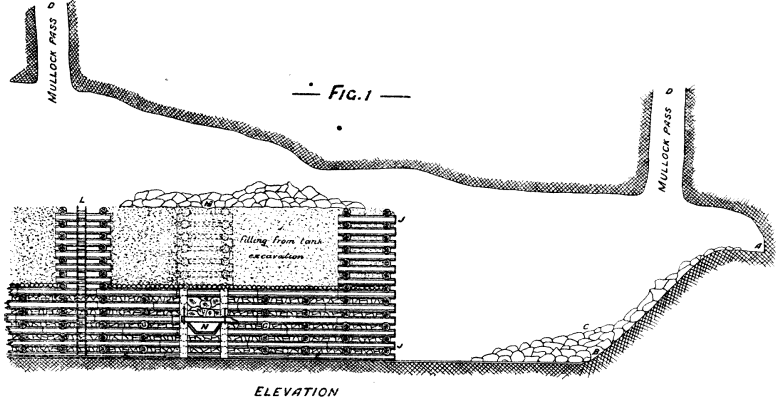
of from 15 to 20 ft. has been attained from the level, when for the time being the stope goes no higher, but a leading cut is carried along at this height, solid ore being left underfoot, but inclining down to the level, so that the broken ore can roll down and be trucked away; the inclined bench of ore being worked away behind as the leading cut advances, but always maintaining its relative inclination and distance.
Fig. 1 gives the elevation of a stope in full work—A is the leading cut, AB the bench of ore left underfoot and inclining away to the level, and which is worked away as the cut A advances, so that the whole face of the stope is worked forward on an incline; the broken ore, c. from the face rolls down this incline, accumulates at the bottom, and is then trucked away. By working in this way the men are always near their work, and are standing on solid ground, instead of on stages, and have an easy means of walking up or down the incline.
After the leading stope has been carried forward some distance, and the broken ore removed, an excavation is left from 15 to 20 ft. high and the full width of the lode, hence to enable the stope to be continued upwards, it is necessary to fill the depleted ground, and to form a level; provision is always made beforehand for filling, by sinking winzes (Fig. 1, D) from the levels above.
To form the level, long stringers of Lachlan pine (Fig. 2, EE) are laid down longitudinally on either side of the truck- road, and 6 ft. apart ; 7 ft. behind these another parallel row is laid down (Fig. 2, FF), and cross-logs GG, are laid across from E to F, every 4 ft. apart: where these stringers and spreaders or cross-logs rest on one another, a scarf is cut out in each, so that they cannot shift; and every log is scarfed out on its under and upper surface. The cross-legs or spreaders overlap the stringers about 6 in., leaving a level 5 ft. wide.
Stringers and spreaders are then built up alternately, until they are 8 or 10 ft. high ; the level is formed by placing smaller round logs (Fig. 3, H) across the top, to cover over the
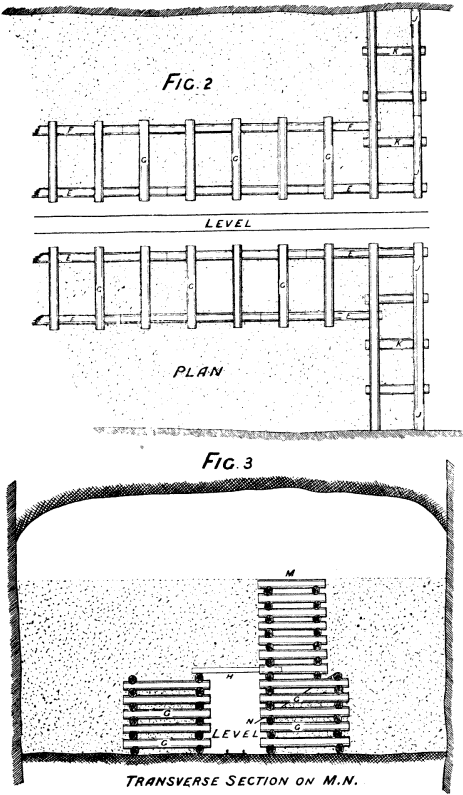
level, and the ground is then ready for filling—but as it is inadvisable to bring the level too near the face of the leading stope, (lest the shooting should break the timber) only the first section of the stope is filled at first; to do this and to keep the filling in its place, a bulkhead (Figs, 1 and 2, JK) is built right across the stope from wall to wall, in exactly the same way as the level timber, but instead of being only 8 or 10 ft, high, it is carried up to the height to which the stope is to be filled, usually about 4 ft. from the back.
As soon as the bulkhead is started, filling is commenced, and the whole timbered part of the stope, together with that between the timber and the walls from its commencement to the bulkhead, is gradually filled, until the filling is within 5 ft. of the back of the stope. The travelling passes (Fig. 1, L) are logged up immediately above the level, while the ore passes (Figs. 1 and 3, M) are built alternately on either side, about 25 ft. apart, and ore chutes, N, put in.
When the stope has been filled sufficiently to allow the men to recommence stoping, the ore is worked up another 8 to 12 ft., the men standing on the broken ore, which is then spalled, put down the passes and trucked away, the bulkhead is built up again, and the stope again filled, and so it goes on until the ore is beaten out to the level above.
But meantime the face of the stope, A, has been advancing, and another section must be filled, so a new bulkhead is started further along; the logs, J, in front of the former bulkhead are drawn and used again, but the spreaders, K, are left in, as they would be too troublesome to remove; the level timber is extended to this new bulkhead, the ground filled, passes logged up, and another cut taken off this section of the stope : in this way stoping is carried on until the end of the ore body is reached, when the level is continued to this point and the whole stope subsequently filled uniformly without bulkheads.
Before the stope is filled, winzes are sunk down to the next level, so that provision is always made beforehand for filling.
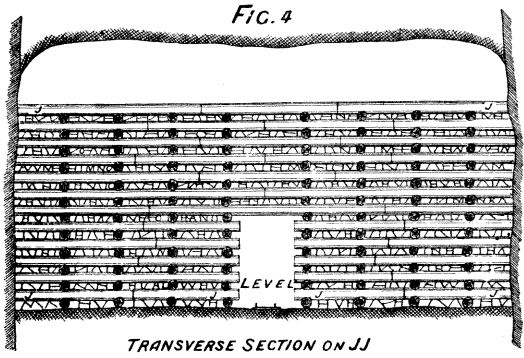
The stringers forming the level and bulkhead timber (Figs, 1, 2, 3 and 4, E and J) are from 9 to 15 ft. long, and where they are joined end to end, the joints are carefully broken, so that no joint is above that in the logs of the row beneath, otherwise it would leave a weakness in the timber. The space between these stringers is filled by using chocks of waste timber, which prevents the filling from working out into the level, strengthens the whole timber, and keeps the miners from using the filling for tamping, and thus preventing cavities from being started in the filling, which would result in endless annoyance in keeping the level clear of earth.
The filling used is red clay, obtained from the tanks which are being sunk all over the company’s property; owing to the dryness of the climate, water conservation is imperative, and by sinking these tanks, they not only conserve the water, but get an excellent binding clay, which after it has been a few weeks in the stopes, becomes so compact and solid that a level can almost be driven in it without timber; it thus arches itself naturally, acts as its own support, and prevents undue pressure on the timber.
The advantages of working the mine in this way are:
- That local timber can be used.
- That only a limited quantity is required.
- That the bulkhead system of building it, gives the maximum strength of the timber to withstand heavy pressures at the minimum of cost.
Some of the old levels in the mine which were timbered by sets, have crushed up almost to nothing, and have had to be re-timbered; the levels timbered by bulkheads have at most crushed down two feet and have never since moved.
Fig. 1. Gives a complete elevation of a stope in full work.
Fig. 2. Is a plan showing how the timbers are laid down.
Fig. 3. Gives a transverse section on the ore pass, M N.
Fig. 4. Gives a transverse section on the bulkhead J K.
The Cobar Gold Mines Timbering
This mine consists of a huge outcrop of quartz carrying a low percentage of gold, and depending for its success upon economic working, and handling on a large scale.
In the early days of this mine, “pig-rooting” was indulged in, and they burrowed after the small patches of rich quartz, but did no good. The present company erected a 100 head stamp battery, and a cyanide plant large enough to treat the tailings, and are crushing over 200 tons of quartz every 24 hours in this case the power to break and treat large quantities of ore has made a success of a mine, which if handled on a small scale would be hopelessly unpayable.
The methods adopted here are:—
- An open cut, which is being extended the full length of the outcrop, and will ultimately be benched down to the No. 1 or adit level, from 50 to 60 ft. below the surface; all the broken ore from the open cut is sent down passes to the level, and trucked away to the battery, and the principle is so universal and well known that no description is necessary.
- Back stoping from the deeper levels which have been driven along the lode from the main shaft.
Instead of forming their levels with bulkheads, as in the copper mine, set-timber is used ; these sets are formed of heavy hardwood logs, brought from Dubbo about 200 miles distant, the sets are four feet apart, with studdles between, and are wide enough to allow for a double truck road, and centre legs between the tracks.
Although these sets are very strong, they would not stand the weight of the filling in the stopes, were the quartz reef removed flush with the level for the full width of the lode (from 30 to 50 feet), hence the quartz is not removed below the caps of the sets, the lode itself thus forming a solid support on either side of the timber as shown in Figs. 5 and 6.
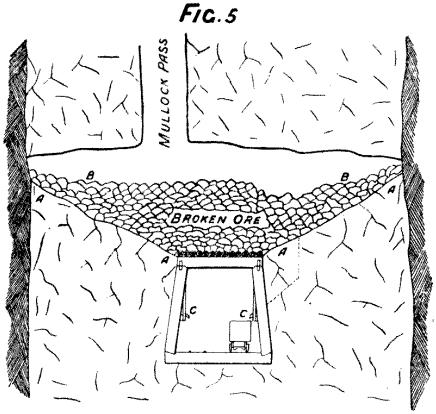
All driving and stoping is done by machine drills, and as soon as the level has been driven and timbered, and the level covered by round poles, E, the stopes are commenced. The reef is worked away from the top of the timber, inclining upwards and outwards to each wall (as shown by Fig 5, AA) ; the broken ore B, accumulates under foot, and is used for the
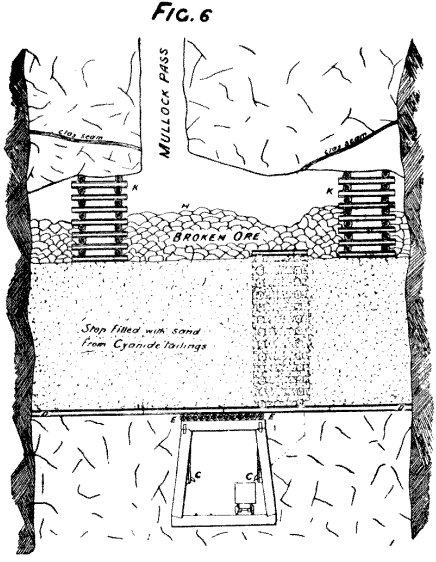
men to stand on to work upwards, and is withdrawn through the ore chutes, c, which are put in every 10 ft. apart, alternately on either side of the level. As soon as the stope has been worked upwards 15 to 20 ft. all the ore is run out and trucked away, and the inclined ore, A A, benched down until it is flush with the caps of the timber, as shown in Fig. 6; round poles, DD, are laid across on top of this bench of ore, from the level to the walls; the poles, E, over the level are covered with brushwood, and the stope is ready for filling. Fig. 7 gives the elevation of a stope from one end to the other, and as in the case of the copper mine the stope is only filled in sections, the principle being (exactly the same in both cases. A bulkhead, FF, (Fig. 7) is built up, (and the stope filled with cyanide sand; the passes, GG, are logged up as usual. As soon as the ground has been filled sufficiently for
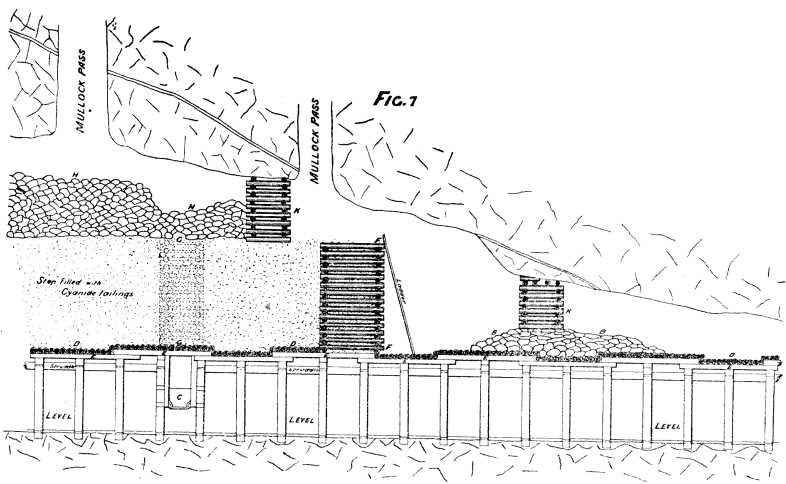
the miners to get at the back of the stope, a further length of 10 to 12 ft. is worked up, the men standing on the broken ore as before, this ore is then run out, the bulkhead, F, built up higher, and the stope again filled. Meantime, as the leading stope is advanced, a fresh bulkhead is built further ahead, the front timbers of the old one removed and another section filled.
Owing to the frequency of the ore passes very little handling is necessary, and enough stone is trucked and hauled in eight or nine hours, to keep the battery going for the full twenty-four hours.
The use of cyanide sand for filling is at present obligatory, because this company is cramped for room to dump their tailings ; but sand is not a good material for filling the stope, because, unlike the clay filling in the copper mine, it will not bind, hence, if a level be 7 ft. wide and the height of filling over it be 30 ft., the sand exerts a tremendous pressure upon the timber, the consequence is that the caps have broken, and collar-legs have had to be put under them, in the centre, to save them.
One would further suppose that the cyanide fumes from the sand would be bad, but as a matter of fact, the ventilation is so perfect that the men never suffer any ill effect, though in a confined, hot mine, there is no doubt but that these fumes would be decidedly deleterious.
The object of placing the poles D.D. (Fig. 6) across the bench of quartz on either side of the level, is to facilitate the picking up of the stope when the stopes from the level beneath come up to it; once the ground beneath, and on either side of the level is removed, the level itself will be no longer wanted and can be allowed to crush in.
Although the ground is fairly strong in this mine, there is a large clay parting rising upwards from the north end of the mine towards the south end, and when in the vicinity of this floor the roof becomes heavy and dangerous. In addition to this, there are other smaller unseen gossan seams, breast-heads, and slippery floors, and it becomes necessary therefore to secure the roof temporarily until these “drummy” pieces of ground are secured; this is done by building up stacks or cribs K K, (figs. 6 and 7) from the sand filling to the roof and wedging them up; in some cases these stacks are put in quite thickly, and are only removed when the stone overhead is to be shot down.
At the commencement of the work, stacks were built off the broken ore, as shown in Fig. 7 K, but this will not be continued, as it prevents the stope being filled, and the quartz from being removed, and renders it difficult and expensive to get at the roof safely to allow of the removal of the stack and the safe running out of the broken quartz.
Timbering of the Prince of Wales Mine, Gundagai
This consists of a quartz reef about 30 ft. wide, between rotten talcose slate walls, the hanging wall especially being very rotten, treacherous, heavy, and full of slipping heads.
The reef underlays at an angle of 45 degrees, and is not solid quartz, the stone being intercalated between bands of slate as shown in Fig. 8.
The reef itself is good standing ground, and had the hanging wall been properly secured at the commencement, no trouble would in all probability have occurred, but misled by the strength of the roof, it was stoped out for some 30 ft. without any support or filling. The hanging wall began to cave, and continued to work away deeper and deeper and higher and higher, until the lode had no support except its own cohesion, which ultimately became less than its weight, and the mine began to creep, and since then has required careful work and a great amount of timber.
The local timber is small and crooked and not fit for sets, therefore stacks are employed as in former cases, except for the levels which are composed of set timber, selected and brought from considerable distances.
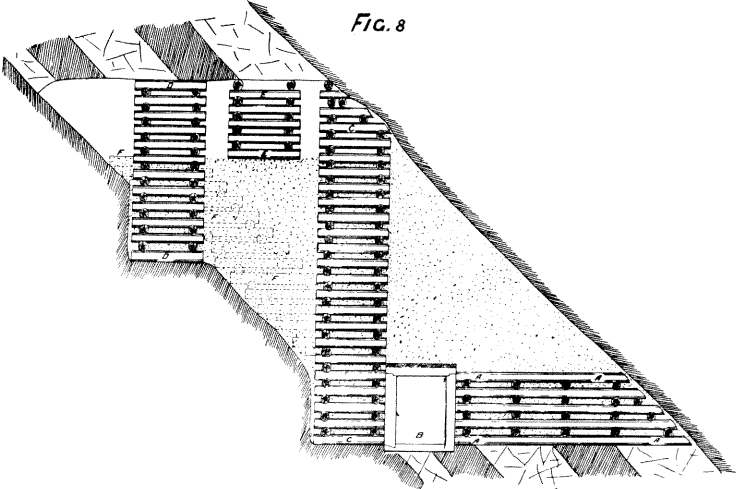
The first levels driven were timbered too lightly, and once stoping began they soon crushed in ; heavier sets were then adopted, but as the reef on either side was stoped out flush with the level, the hanging wall began to move, and this combined with the weight of the filling soon caused these also to crush.
Taught by experience the manager then put bulkheads right along the levels from end to end outside the sets, as shown in Fig. 8 where B is the level, A.A. the bulkheads. As the stope was filled, stacks of timber were started off the filling and built up to the roof and wedged up, but the shrinkage of the filling drew these stacks away from the roof and the creeping continued.
At this stage Mr. G. H. BLAKEMORE took charge of the mine and at once introduced the present method. Instead of building the stacks promiscuously off the filling, they were started off from hitches cut in the solid foot wall, and continued right through the stope, until the hanging wall was reached, when they were wedged up; while passing through the stope they support the roof. These stacks are built systematically in rows, the stacks of each row being either directly above those in the row beneath, or else alternating with them. Fig. 8, cc, shows one of these completed stacks; DD shows one passing through the stope and serving to support the roof; while BE shows a stack built off the mullock filling. These latter stacks are only supplementary to the main ones, and are put in to strengthen the ground and to support smaller areas of loose ground between the main stacks. All of these are filled with mullock, to give rigidity,and stability, and lagging of round poles is placed across from stack to stack where necessary, to keep the men under cover. Though subjected to great pressure, these stacks have answered admirably, and the ground hithterto removed without accidents.
One great improvement, which would save building the bulkheads, A, and would economise timber, would be to drive the main levels entirely in the footwall; the reef underlays so much, that it would be equally, if not more convenient, and the level could never crush, and it is so obvious an improvement that it is a wonder it has never been adopted.
The ore passes (FF, Fig. 8) are built as shown, either along the hanging or footwall sides, as are also the travelling passes.
Timbering the Sybil Mine, Gundagai
This adjoins the Prince of Wales, and at one time the two mines were worked in conjunction, and the same system
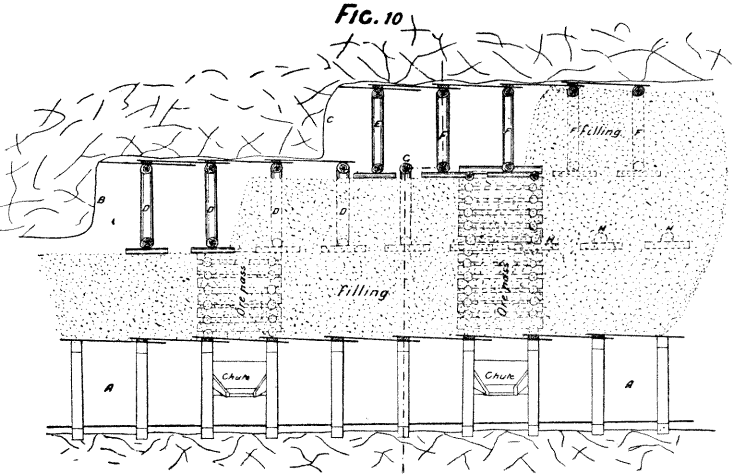
adopted; but to save timber, and as it was believed, to increase the security of the mine, another system was adopted by Mr. BRAIN, when he took the management. This consists of using sets similar to the square sets at Broken Hill, but as the complete square set system, where the timber is buried, would be too costly, and render the mine hopelessly unpayable, they only timber one stope, and as the next stope comes over it, the legs from that beneath are drawn and used over again, lagging being kept overhead. The same legs, caps, and laths are thus used from the commencement to the completion of a stope, from level to level, and only the bed logs and groundsels, on which the legs rest, are lost.
The level AA, (Fig. 10) is driven and timbered in the usual way, but instead of working the stopes out on stacks, they are worked out on sets similar to those used in the drives; groundsels, however, being used instead of sole plates.
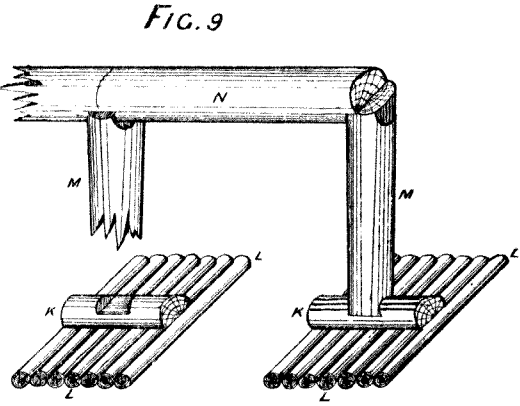
Fig. 9 gives a view of the method of framing the stope sets. Poles of round timber, LL, are laid down longitudinally, on the mullock filling in the stope, across these poles a baulk of timber, K, is laid, joggled out on its upper side for the leg of the set to rest in. The leg, M, is always placed in this, with the small end down to facilitate drawing it; the upper end of the log is squared for the cap, N, but is not joggled, “ clap-me-down ” sets being used. The end of the cap reaches half-way across the top of the leg, giving room for the next cap to be joined to it. Fig. 9 will make the method of framing the stope sets perfectly clear.
Now suppose a stope is in full work, as shown in Fig. 10; AA, is the level, B is the face of any stope being worked in it, DDD are the sets put in as described above, with lagging over the top to secure the ground : as the face of the stope, B, is advanced and the ground timbered, the portion of the stope already depleted is filled, partly with waste mullock from the lode, and partly by mullock run from the surface.
As soon as the face, B, is well ahead, another stope, C, is started above and 4 or 5 sets behind it, and follows it in, being timbered, worked, and filled behind in exactly a similar way to the stope below, but when the set, E, is put in, the cap of the set, G, beneath it is removed, a chain put round the top of the leg, G, and this leg drawn. The set, G, is then used for the next set of stope c; and so the stopes advance, the sets in the stope beneath being drawn as they are uncovered and used over and over again—the only loss of timber taking place is the round bed logs and groundsels, H, which are buried.
Fig. 11 gives a transverse section of the stope on any of the sets, D.
If the lode is very wide, the face of the stope is not advanced uniformly, but is worked ahead in strips, one strip of any stope being kept ahead of another; in this way only a small area of ground is open at any one time, and the maximum of strength is obtained. If the ground be very heavy the sets are studdled or tommed back from one to the other; but in this mine the ground is open for so small a space of time that this not considered necessary, battens being nailed to the two front sets to keep them from canting when the laths are being driven up overhead.
A stope some 100 ft. long and 100 ft. high and 25 or 30 ft.
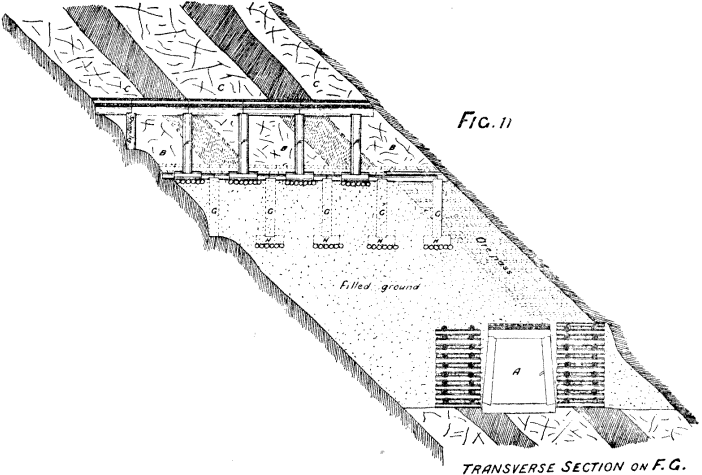
wide was worked out in this way, and the initial cost of timber was £35, and no further cost was entailed.
The cost of working it out on stacks is unknown to me, but would probably be nearly £200, and then the timber is lost permanently. By this method only the legs next the hanging wall in run of stopes is lost, the remainder being used over and over again from level to level,
Unfortunately Mr. BRAIN did not have a chance of trying this system on the heavier ground in the neighbourhood of the Prince of Wales Mine, which was worked out on stacks; where he tried it the ground was less treacherous, and as it had never been subjected to a creep, a comparative test was not made.
The only possible objection to the system is, that the shrinkage in the filling as it packs down would draw the timber away from the roof and allow it to start, when the pressure would be too heavy for the strength of the timber. The method has, however, been tried elsewhere, and acted satisfactorily, and by adapting it to the varying conditions of different localities, there is little doubt in the writer’s mind that it would be perfectly safe.
Its advantages are:
- Great economy.
- That the men are always protected by timber overhead.
- That owing to the short time any particular set is in use, and the fact that the ground is close filled, there is no room for any big movement in the ground, and if the system is adopted from the start of a mine it is hardly possible for the ground to get away.
This completes the review of the four mines taken as examples. The description of the square set system formerly used at Broken Hill is not given, because it is fully described in one of the Annual Reports of the New South Wales Department of Mines some years ago—and a very excellent perspective drawing, with description of the method, can be seen in W. H. STORM’S admirable little book on “Methods of Mine Timbering,” published by the California State Mining Bureau.
The rapid-advance in the adaptation of scientific knowledge to the treatment of ores, resulting in improved chemical and metallurgical processes, has enormously increased the possibility of working lodes profitably, which a few years ago were passed over as unpayable. By the discovery of chlorination, and later of “ Cyanidation,” by the highly improved methods of concentration, and by the rapid advance in our knowledge of smelting (for which we are greatly indebted to American metallurgists), and by the gradual replacement of scientific principles and enlightened management, for rule-of-thumb methods formerly in vogue, many large low grade bodies have been opened, and are now paying dividends, which were, twenty years ago, looked upon as hopelessly unpayable.
